
Last weekend (27 August 2016) I attempted and completed what, to date, is the toughest physical challenge I’ve ever asked my body to try before – a 35 km / 21 mi terrain run in the Nuuk backcountry, called the KangNu Running Race.
This run took me completely outside my comfort zone, which I could notice just from the amount of nerves and second thoughts I was having all the way up to the word, “Go!”
In contrast to the weekend prior, when I was pumped and excited to compete in the Inua Challenge, I wrote this on Facebook, three days prior to race day:
There’s no way back now… I got my start number tonight, so I’m ‘ready’ to run 35 km / 21 mi around Kangerluarsunnguaq fjord on Saturday for the KangNu Running Race.
Two years ago, I ran the 20 km / 12 mi route so of course this year I had to push myself a little more, right?! What the f*** am I thinking?!?! Maybe, ‘Hey, it’s been a tough 1.5 months, so what’s one more tough thing on the pile?’ After a hard Inua Challenge last weekend, I had otherwise considered cancelling my registration for KangNu.
Yeah, whether I run the whole way or walk a little, or certainly cry and curse a little, I know I can get through it physically because I’ve trained for the last 8 months in a row (and that I had absolutely not done back then) but anyway… 10,000 butterflies have suddenly come in my stomach, and fast!
Now it’s just a question of preparing myself mentally over the next few days.
Read my inner monologue below to see how I got through this challenge of a lifetime.
0.8% OF NUUK’S POPULATION, SCATTERED IN THE FJORD
All in all, 137 people sailed over to Kangerluarsunnguaq fjord to be dropped off in the nature and to run home. (It’s sooo Greenland!)
We were 21 persons strong who had the same crazy idea to run the 35 km / 21 mi route – 13 men and 8 women. It does make me proud that, out of 8183 women living in Nuuk, we were the 8 who wanted to take on the challenge this year. It also makes me proud that 5 out of the 8 are CrossFitters!
Another 36 people had the bright idea to do the 20 km / 12 mi terrain run, and yet another 80 people selected to hike the 20 km route.
THE MORNING OF RACE DAY
 Me in the 7:00 hour on board the boat that sailed us to the starting line. I’m clearly blissfully unaware of what lies ahead. Photo by my friend and Crossfit Inua teammate, Inaluk Brandt.
Me in the 7:00 hour on board the boat that sailed us to the starting line. I’m clearly blissfully unaware of what lies ahead. Photo by my friend and Crossfit Inua teammate, Inaluk Brandt.
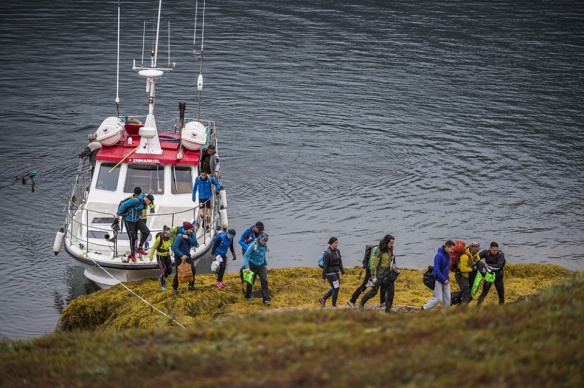 One boatload of people – that’s all who was
One boatload of people – that’s all who was brave crazy enough to want to do the 35 km KangNu race this year. Photo by: Leiff Josefsen for this Sermitsiaq.ag news article.
 8:00 – We’re off! Photo by: Leiff Josefsen for this Sermitsiaq.ag news article.
8:00 – We’re off! Photo by: Leiff Josefsen for this Sermitsiaq.ag news article.
9 HR 29 MIN 35 SEC OF ONE FOOT IN FRONT OF THE OTHER
It’s a long time to be at the same activity, the same action. Something around 53000 steps. Zoning out was not an option as traversing Greenlandic terrain takes awareness and concentration.
The boulders along the beach are huge and rough and sharp, and if they’re wet or covered in seaweed and moss, as many were on race day, one incorrect step could go horribly wrong. The hills are covered in soft moss and a crowberry & blueberry ground cover that is deceptively soft, so one always has to take care not to hyperextend a knee or roll an ankle. And there is no red carpet path cut for you – sometimes one really has to use their nature-sense to search for the route, for example to look for places where the grass is flattened a bit from runners that have already passed through.
HAPPINESS, FRUSTRATION, ACCEPTANCE, AGONY, SECOND-WIND, PRIDE, GRATITUDE
This was the gamut of high and low feelings I went through in the course of the race.
Happiness – The first 2.5 hours were absolutely lovely – the view running into the bottom of the fjord was stunning, and the air was fresh. The terrain was exactly as I expected it to be, and I settled into a nice pace. While I didn’t set any sort of goals for myself for this run in terms of time or pace, I had always generally envisioned that I would run the whole way, nice and easy, if the terrain was just like this.
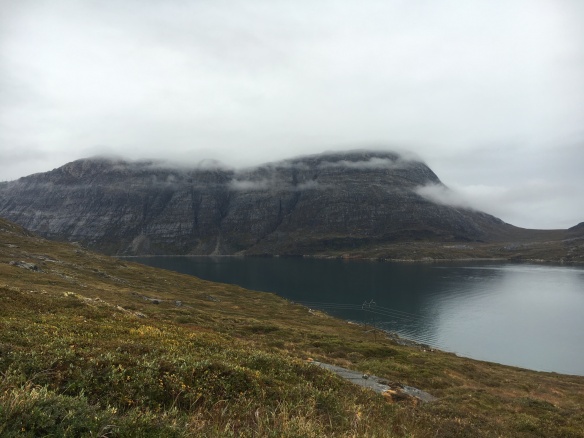 The enjoyable terrain to run on – slightly rocky, slightly soft groundcover of crowberry and blueberry, with steady elevation maintenance. The first 5-8 km.
The enjoyable terrain to run on – slightly rocky, slightly soft groundcover of crowberry and blueberry, with steady elevation maintenance. The first 5-8 km.
Frustration – But the terrain was not just like this forever. At some point when we were uphill, a boat of judges sailed next to us in the fjord and shouted up to come downhill to run along the beach.
Nice white sandy beach? Not a chance. It was rocky and slippery, eventually turning into humongous boulders way larger than my body size. At first I could run on the rocks because they were small, thanks to my new Salomon Speedcross 4 shoes, but eventually it turned into one part walking, one part running as I grew more and more uncomfortable, getting scared to land wrong on my foot. I was getting so frustrated at the terrain, feeling it was hindering all my mental preparation of planning to run the whole way.
 The hellish terrain to run on – wet rocks that only got bigger and tougher in time, with gaining elevation. The next 5-8 km.
The hellish terrain to run on – wet rocks that only got bigger and tougher in time, with gaining elevation. The next 5-8 km.
Acceptance – But for me, an inexperienced terrain runner, it wasn’t possible for me to run on the beach anymore, and I slowed to a “purposeful walk”. I had so much wish to run, but I just couldn’t. Eventually I accepted that I will just have to walk until we get out of the beach area, whenever that is… Somewhere in this period I picked up my friend and Crossfit Inua teammate who was walking a bit behind me, and we continued the rest of the way together, which I was so thankful for because, looking back, I don’t think I was mentally prepared enough to run this race alone.
Turns out it was another 2 hours nearly to get off the beach, only to be followed nearly immediately by a large uphill rocky stretch that was so steep there was a rope to guide the way. So the walking continued.
Agony – After coming through the first 15 km / 9 mi of the route along the rocky “beach from hell” and the uphill climb through the rocks, my hips were basically dead, and every step felt like fire. There were a few big steps up in the rocky uphill climb that I was nearly having to help lift my own leg up. It was somewhere along here that we picked up another friend and Crossfit Inua teammate who had been ahead of us, so then we were 3.
When we got to the start line of the 20 km / 12 mi KangNu race, it was a welcome and familiar sight because I knew the route from here, and I knew terrain was easy-cheesy compared to the previous.
Again I had so much wish to run – mostly to avenge the walking stretch – but my hips were simply in too much pain. I was getting frustrated and angry again that I used so much energy on the first stretch, that by the time I got to where it was possible for me to run, I couldn’t. Every single step for the next hour and a half was painful and slow-going. When we reached the second uphill climb of Ukkusissat Kangilequtaat, there was a silent pep-talk in my head for every single step. Take a step. One more. Another.
 Smiling and having fun was the only way to get through it. Heading uphill on Ukkusissat Kangilequtaat. Somewhere around the 20th km / 12th mi.
Smiling and having fun was the only way to get through it. Heading uphill on Ukkusissat Kangilequtaat. Somewhere around the 20th km / 12th mi.
Second-wind – When we got to the top of the hill, there was a refuel station with chocolate, oranges, power bars, and juice – the first we’d encountered in maybe four hours’ time, although we had our own personal stocks in our backpacks, too. Having this extra fuel, plus knowing the 10 km left in the route were all downhill from here, was a boost for us, and we started to run. My hips were definitely still on fire, but the angle of running downhill changed the pressure, and I was able to run through it.
Not to mention, we suddenly saw ahead of us a group of 4 people hiking – they were the last of those who chose the 20 km KangNu hike. It was a self-centered yet soooo-needed mental boost to know that we had been through 15 km more terrain than them and still had enough gas to forge ahead past them. We eventually saw and passed another 5 hikers when we got closer to town.
 The downhill home stretch has really beautiful and dramatic nature.
The downhill home stretch has really beautiful and dramatic nature.
Pride – When we got to the final meters of the home stretch to Inussivik sports hall, we could hear music playing, and suddenly the MC’s were saying our names over the loud speaker to announce we were coming into the finish line. I was getting goosebumps thinking, “We actually did it!!” I truly was in shock and disbelief that I came through it.
It was such a big experience to cross over the finish line with my friend while giving her a high five, and to see our third friend waiting there, who had finished 3 minutes before us. It was a feeling of accomplishment and pride that I’ll never forget.
 KangNu 35 km complete!
KangNu 35 km complete!
Gratitude – The day after the race I was actually in way better recovery shape than I would have guessed. Still a bit swollen and tender in my hips, but with perfectly fine knees and ankles, and not a single blister on my feet!
Mostly I was so happy to have had the opportunity to try such a run and to have had two friends by my side. I wrote this on Facebook that day:
We talk frequently about PR’s in CrossFit – one kilo more, maybe five. These numbers are big and a lot to be proud over, and that I am, when they happen, but what I experienced yesterday gave me a much greater feeling of pride, which I will live off of for many years.
Yesterday I stepped outside the comfort zone; I moved my limits. I am not a runner, nor am I a terrain runner. I have only done such a run once before, and that was in 2014 for the KangNu 20 km / 12 mi. And, not to mention, a few weeks ago I was even fighting mentally to get through 5 km / 3 mi on the treadmill. But for some reason I thought I should try the KangNu 35 km / 21 mi in 2016. Maybe because I think I’m generally in good shape. Was that dumb? No. It was insane.
Therefore, when I crossed the finish line yesterday together with two of my super strong CrossFit friends (and let me be clear, I only crossed the finish line because they were there with me), I got a PR of 15 km’s / 9 mi’s run out in the most beautiful but harshest nature. It’s nearly incomprehensible for me.
That I will remember as, until now, the biggest personal challenge I have ever overcome.
Today’s going to be a good day ❤
THE SAME THREE THOUGHTS RUNNING ON LOOP + A SONG
Due to the necessary situational awareness one needs when running in the backcountry, I was mentally present the whole time, and I kept coming back to the same few ideas. One was:
“There’s a finish line at the end of today’s race, but the purpose is not to cross it. The purpose is to enjoy all the steps it takes to get to it.” – Words I wrote on Facebook after being totally inspired by a Tree of Life film clip just before going to sleep the night before the race
So many times I was “waking myself up” to stop for a minute to look around at the indescribably beautiful country I am privileged to call home. I was thinking, “Of course I will sail in this fjord maybe one hundred more times in my life, but will I ever be in this spot running again? Probably not. NOW is the time to appreciate this experience. “
* / * / *
The second was:
“Every once in a while one needs to move his/her boundaries. You can do it.” – Motivational words written to me by a friend, on the morning of the race
Original: “Man skal jo engang imellem flytte sin grænser. Sapinngilatit.”
There were many times I was feeling that I was really overstepping my boundaries of what is realistic for me based on previous experience. As I’ve said, I’ve only done trail running once before, (read here about my experience two years ago for the KangNu 2014 race), and that was the much easier and shorter 20 km / 12 mi KangNu route, so maybe a 15 km / 9 mi increase through much tougher terrain was too much of a jump?
But then I rationalised, if I thought the idea of a 35 km terrain run was just completely impossible for me, I never would have considered it in the first place. So the very fact that I considered and decided upon it, means I subconsciously always believed I could do it.
I also rationalised that others, like my friend who wrote to me, must have also believed I could do it. Not a single person questioned, “Are you sure? Do you really think you can do that?” when they heard I will go for the 35 km route.
* / * / *
Finally, the third was:
“You are her happiness”. – Words written to me by a family friend about me & my mother.
I thought frequently of my mother, who is a paraplegic due to Multiple Sclerosis and who, over the course of the last 30+ years, has acquired more and more machines to carry out basic functions, the latest being a breathing vent.
I was thinking about how I use my body so much – daily CrossFit training, hiking, and special events like Inua Challenge and KangNu – while she’s sitting there not even able to lift her own hand. The contrast of my life versus hers is astounding.
I’ve always sort of scoffed at people who ‘run in the honor of…’ or ‘run in the memory of…’ people, but I get it now. Every time I came to think of these words by the family friend, I thought also, “I will complete this for her, to be her happiness.”
And the song? Taro by Alt-J.
NO INSTANT REPEATS
I am really glad that I stuck with it and somehow squashed the voice that screamed to me to back out. Crossing the finish line was a true moment of completely obliterating any physical limitations I thought I had, and taught me something about my own strength.
Will I do the 35 km KangNu terrain run again? No, never. Ironically, to now know the terrain that lies ahead means I’ll never get through it again.
Will I do some other physical challenge that presses me just as much, or more? Absolutely. Eventually. Maybe hike the 160 km / 96 mi Arctic Circle Trail between Kangerlussuaq and Sisimiut… maybe run/hike the 120 km / 72 mi Nuuk-Kapisillit terrain race… maybe run the Nuuk Marathon…
But with winter coming, and being that I’m not a downhill or cross-country skier, I think my opportunities for outdoor challenges have run their course for 2016. I’m more than satisfied to call the 35 km KangNu race my final physical accomplishment hoorah for the year.

 Photo by: Mads Pihl / Visit Greenland
Photo by: Mads Pihl / Visit Greenland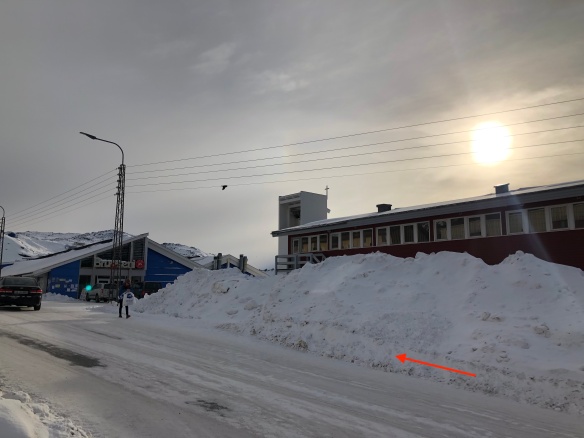
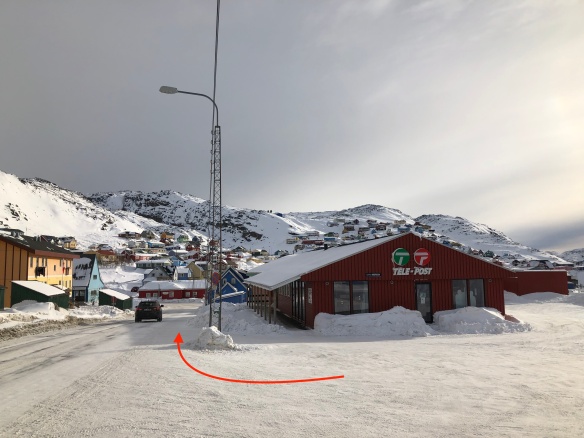
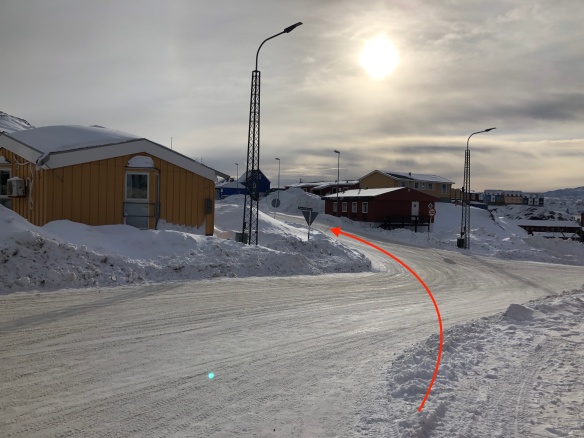
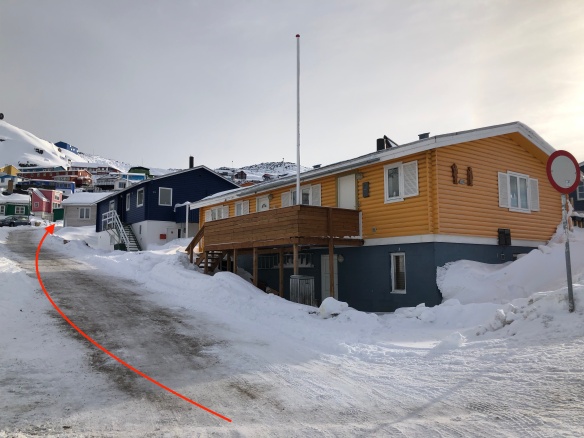

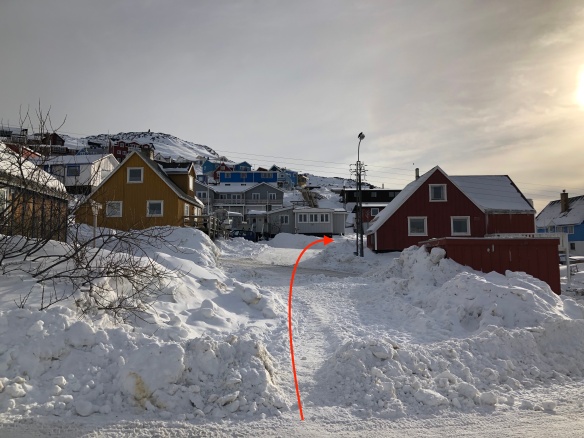
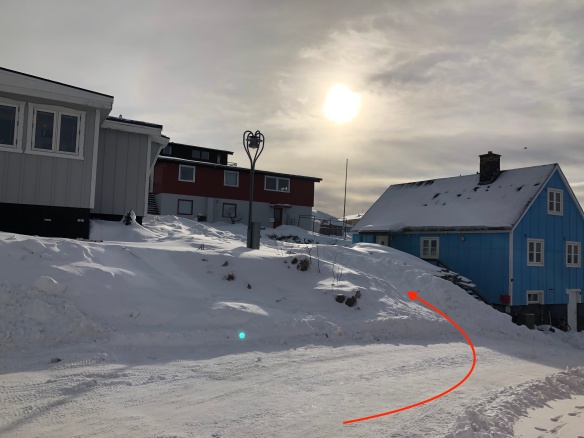
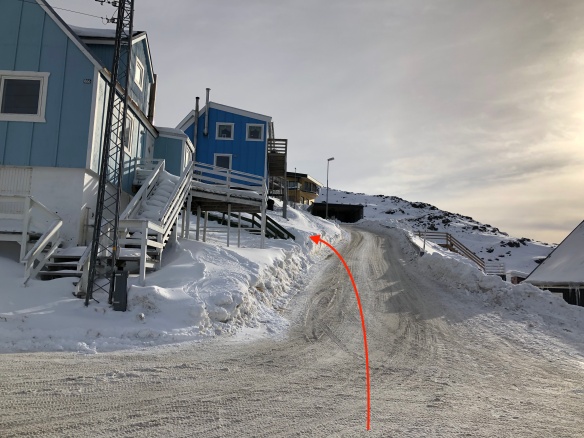

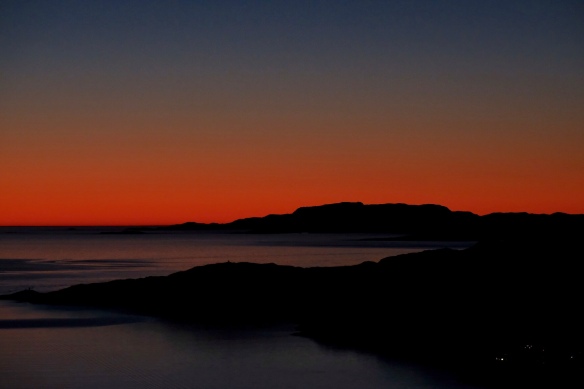

































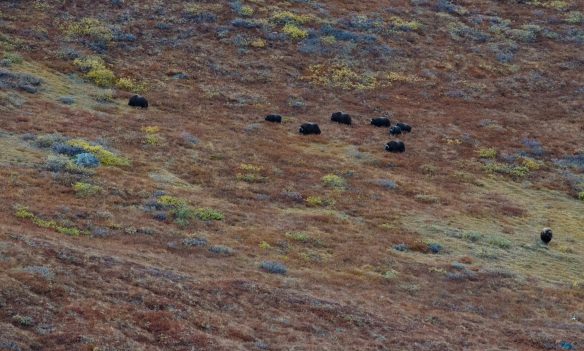
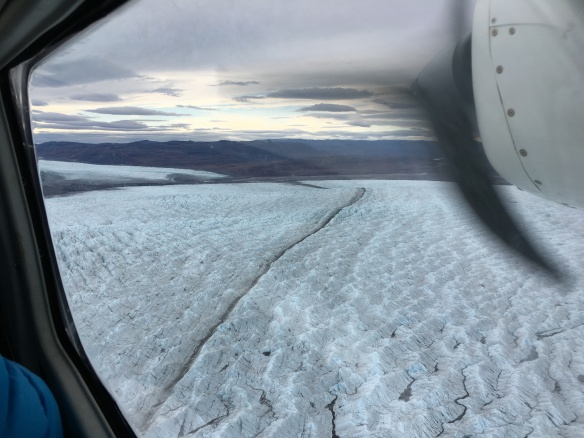
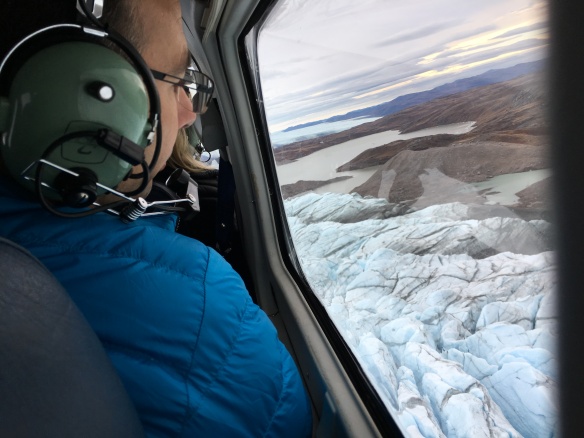


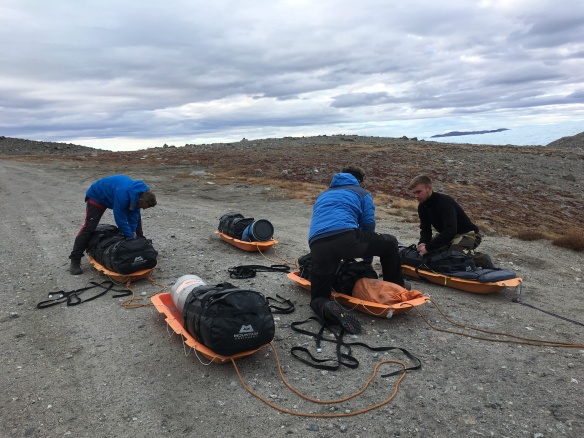
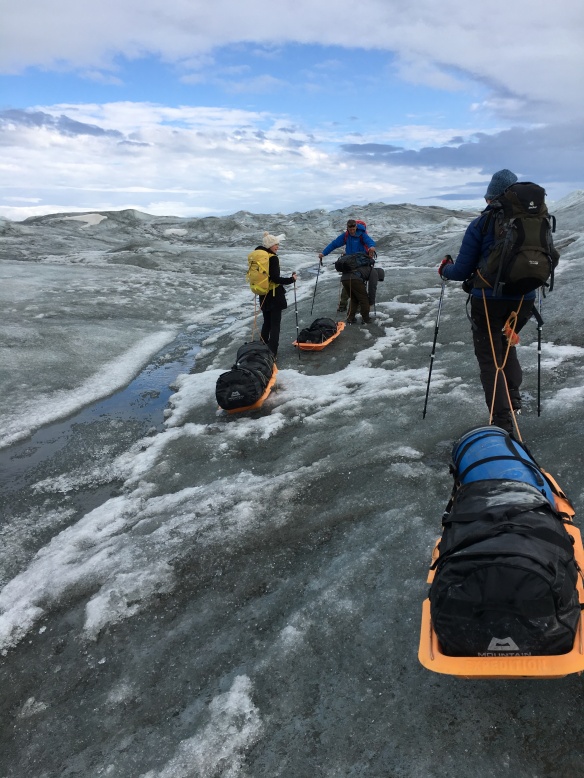

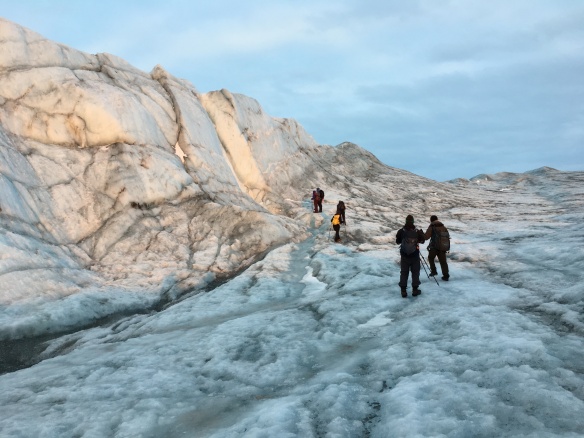


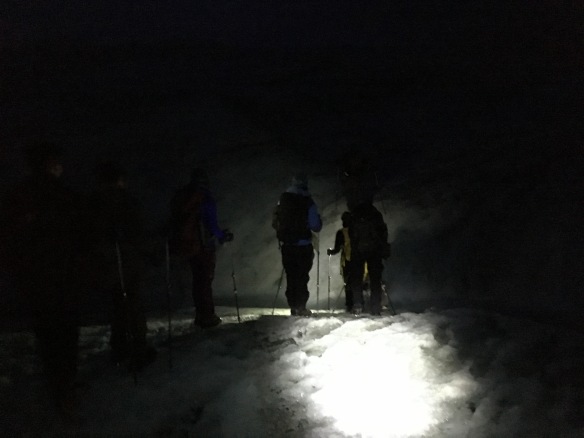
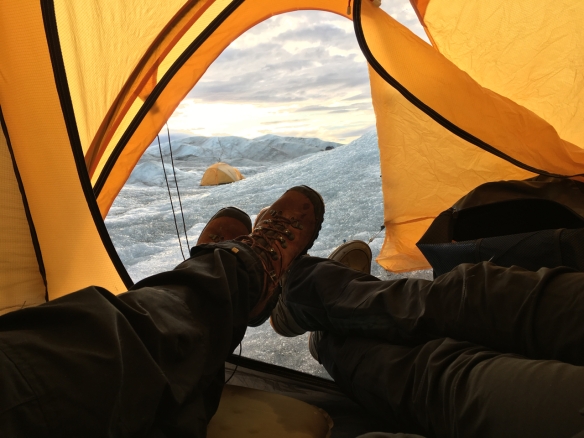

 Me in the 7:00 hour on board the boat that sailed us to the starting line. I’m clearly blissfully unaware of what lies ahead. Photo by my friend and
Me in the 7:00 hour on board the boat that sailed us to the starting line. I’m clearly blissfully unaware of what lies ahead. Photo by my friend and  One boatload of people – that’s all who was
One boatload of people – that’s all who was  8:00 – We’re off! Photo by: Leiff Josefsen for
8:00 – We’re off! Photo by: Leiff Josefsen for  The enjoyable terrain to run on – slightly rocky, slightly soft groundcover of crowberry and blueberry, with steady elevation maintenance. The first 5-8 km.
The enjoyable terrain to run on – slightly rocky, slightly soft groundcover of crowberry and blueberry, with steady elevation maintenance. The first 5-8 km. The hellish terrain to run on – wet rocks that only got bigger and tougher in time, with gaining elevation. The next 5-8 km.
The hellish terrain to run on – wet rocks that only got bigger and tougher in time, with gaining elevation. The next 5-8 km. Smiling and having fun was the only way to get through it. Heading uphill on Ukkusissat Kangilequtaat. Somewhere around the 20th km / 12th mi.
Smiling and having fun was the only way to get through it. Heading uphill on Ukkusissat Kangilequtaat. Somewhere around the 20th km / 12th mi. The downhill home stretch has really beautiful and dramatic nature.
The downhill home stretch has really beautiful and dramatic nature.  KangNu 35 km complete!
KangNu 35 km complete!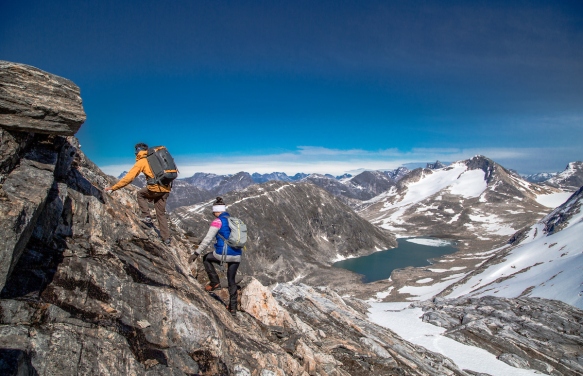
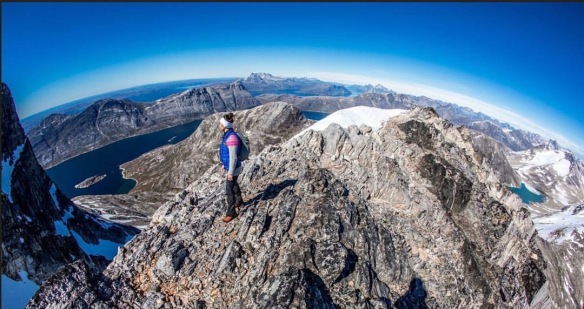
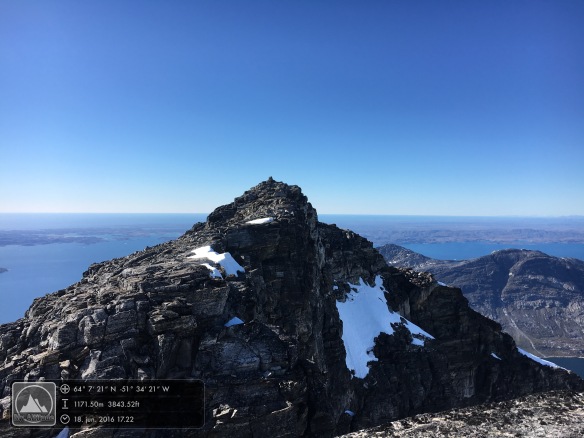
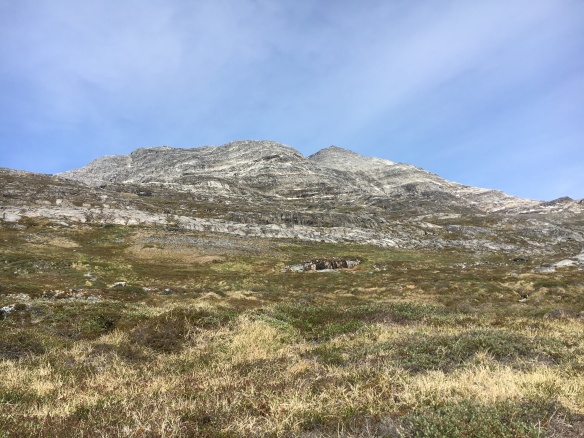 Hiking from sea to summit is no small feat. Sometimes one thinks, “Can I REALLY do this?” The answer is Yes, you can! Just put one foot in front of the other. The bottom half of the mountain is grassy/mossy/shrubby terrain, which I personally think is tougher on the legs than the rocky part.
Hiking from sea to summit is no small feat. Sometimes one thinks, “Can I REALLY do this?” The answer is Yes, you can! Just put one foot in front of the other. The bottom half of the mountain is grassy/mossy/shrubby terrain, which I personally think is tougher on the legs than the rocky part. And anywhere there’s lush green terrain, there’s fresh running water sources. It’s special about Greenland to be able to drink directly from a stream or waterfall. Here we are at approximately 219 m / 719 ft above sea level.
And anywhere there’s lush green terrain, there’s fresh running water sources. It’s special about Greenland to be able to drink directly from a stream or waterfall. Here we are at approximately 219 m / 719 ft above sea level.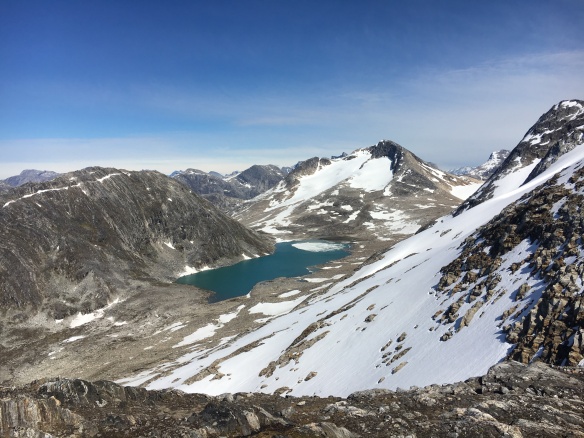 Spectacular outlook point from the saddle at approximately 800 m / 2625 ft above sea level. This is the shot that made some locals think it was East Greenland! The first of two best experiences of the whole day.
Spectacular outlook point from the saddle at approximately 800 m / 2625 ft above sea level. This is the shot that made some locals think it was East Greenland! The first of two best experiences of the whole day.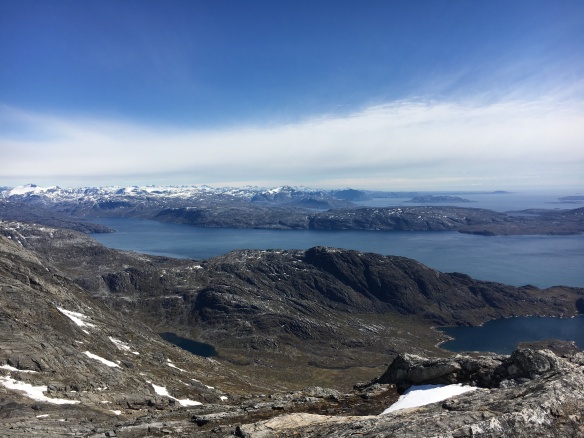 Here solidly into the rocky terrain, between 800-900 m / 2625-2953 ft above sea level, looking southward. It’s scrambling / bouldering from here on up, with more than a few narrow passes.
Here solidly into the rocky terrain, between 800-900 m / 2625-2953 ft above sea level, looking southward. It’s scrambling / bouldering from here on up, with more than a few narrow passes.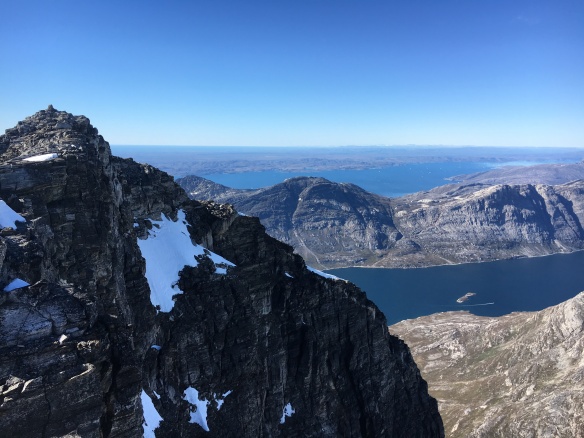 My favourite perspective, actually. There’s something about the steep wall of Kingittorsuaq in the foreground, Kangerluarsunnguaq fjord in the middle ground, and Nuuk Fjord beyond. You can see everything. Approximately 1169 m / 3834 ft above sea level.
My favourite perspective, actually. There’s something about the steep wall of Kingittorsuaq in the foreground, Kangerluarsunnguaq fjord in the middle ground, and Nuuk Fjord beyond. You can see everything. Approximately 1169 m / 3834 ft above sea level. 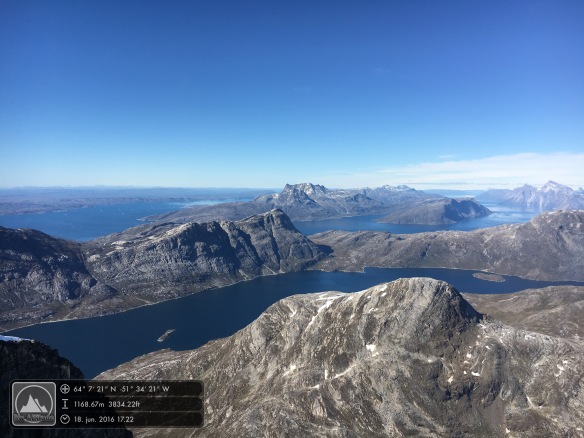 So beautiful and clear day. Feels like you could see all the way to Canada. Looking north into Nuuk Fjord. Four hours into the hike.
So beautiful and clear day. Feels like you could see all the way to Canada. Looking north into Nuuk Fjord. Four hours into the hike.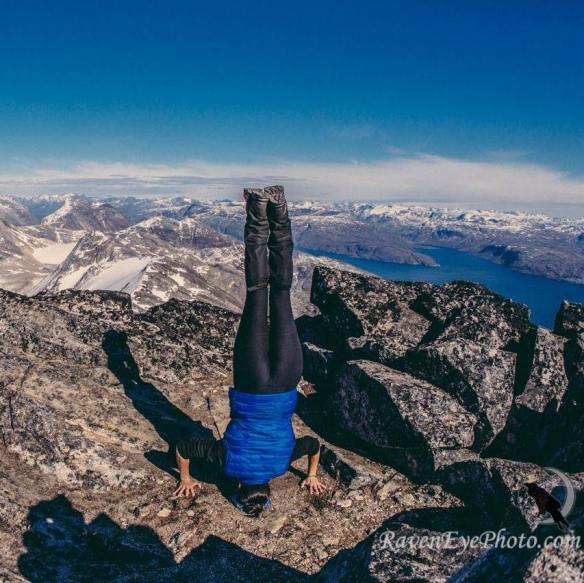 Beautiful overlooks deserve a yoga moment. Photo credit: Raven Eye Photography.
Beautiful overlooks deserve a yoga moment. Photo credit: Raven Eye Photography.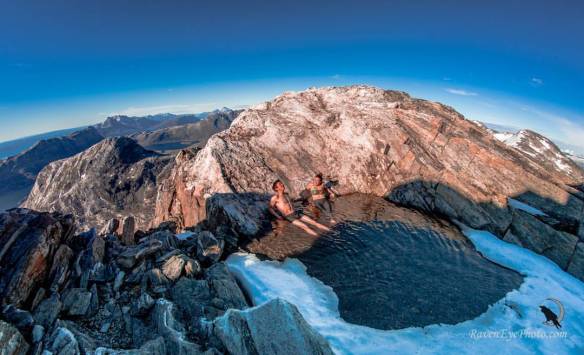 And little ponds of snowmelt deserve a quick dip. No, it wasn’t the slightest bit warm, but sometimes you just know when you’re NEVER going to get the same chance again, so it’s now or never. The other best experience of the entire day. Photo credit: Raven Eye Photography.
And little ponds of snowmelt deserve a quick dip. No, it wasn’t the slightest bit warm, but sometimes you just know when you’re NEVER going to get the same chance again, so it’s now or never. The other best experience of the entire day. Photo credit: Raven Eye Photography. 

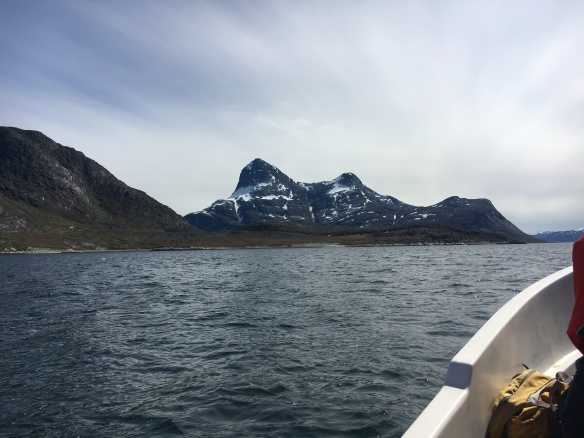 Kingittorsuaq is the double-peaked mountain. The left peak is, clearly, the higher of the two and is the true summit.
Kingittorsuaq is the double-peaked mountain. The left peak is, clearly, the higher of the two and is the true summit. Taking in the sights at 1170 m / 3842 ft on Kingittorsuaq. FANTASTIC view over the entire world, it feels like. Note the clothing.
Taking in the sights at 1170 m / 3842 ft on Kingittorsuaq. FANTASTIC view over the entire world, it feels like. Note the clothing.









 Southerly view over the Ilulissat Icefjord toward the sunrise, standing at Seqinniarfik. Photo taken: 13 Jan 2016.
Southerly view over the Ilulissat Icefjord toward the sunrise, standing at Seqinniarfik. Photo taken: 13 Jan 2016.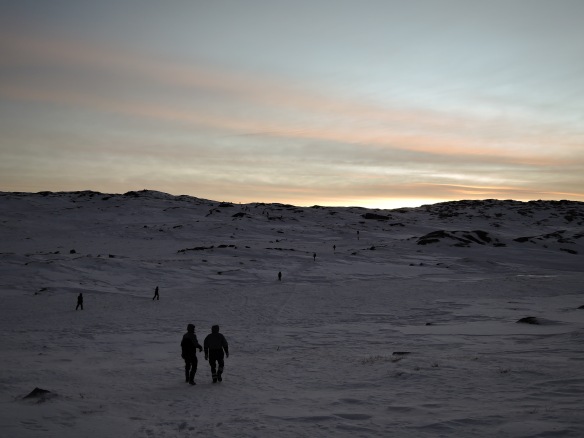 Starting out toward Seqinniarfik. Check the tiny dots (people) on the top of the hill! And that’s not even the final spot. Photo taken: 13 Jan 2016
Starting out toward Seqinniarfik. Check the tiny dots (people) on the top of the hill! And that’s not even the final spot. Photo taken: 13 Jan 2016 Seqinniarfik selfie. At the top. Photo taken: 13 Jan 2016.
Seqinniarfik selfie. At the top. Photo taken: 13 Jan 2016. View over Ilulissat. Photo taken: 13 Jan 2016.
View over Ilulissat. Photo taken: 13 Jan 2016.







